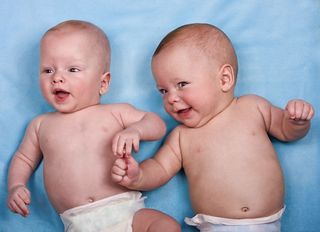
SAN FRANCISCO – Identical twins may not be so identical after all. Even though identical twins supposedly share all of their DNA, they acquire hundreds of genetic changes early in development that could set them on different paths, according to new research.
The findings, presented Friday (Nov. 9) here at the American Society of Human Genetics meeting, may partly explain why one twin gets cancer while another stays healthy. The study also suggests that these genetic changes are surprisingly common.
"It's not as rare as people previously expected," said study presenter Rui Li, an epidemiologist at McGill University.
While past studies have looked at genetic changes, or mutations, in sperm and eggs, which can be passed on to offspring, very few studies have looked at somatic mutations. These mutations, also called copy errors, can occur early in fetal development, but because they aren't in the sex cells (the X or Y chromosomes) of the fetus, they can't be passed on.
Other studies have shown that chemical modifications, or epigenetic effects, can change which genes are expressed over the years, one factor that renders twins not completely identical. Still, other work has shown that identical twins can have different gene mutations, but this study didn't determine how often they occur.
To find out how often these mutations occur in early development, Li and her colleagues studied the genomes of 92 pairs of identical twins and searched hundreds of thousands of sites in their genomes for differences between twins in base pairs, which are represented by letters that make up DNA. For instance, one twin may carry an A at one point while another carries a C. The researchers could only detect differences that would occur very early in fetal development and would show up in most cells in the body.
They then calculated the frequency with which these mutations occurred. Only two sets of twins had such mutations, which translates to a DNA change occurring once for every 10 million to 10 billion bases that are copied every time a cell divides. While that may seem like a high accuracy rate, cells in the body divide trillions of times. So that would mean an average twin pair carries 359 genetic differences that occurred early in development.
Sign up for the Live Science daily newsletter now
Get the world’s most fascinating discoveries delivered straight to your inbox.
One limitation of the study is that they could only estimate the mutation rate based on blood cells, but some cells in the body divide much more frequently and so may rack up many more mutations. Other cells, like brain cells, don't regenerate much and would probably remain stable.
"Our DNA samples came from blood samples," Li told LiveScience. "You need to define different rates in different tissues."
Follow LiveScience on Twitter @livescience. We're also on Facebook & Google+.

Tia is the managing editor and was previously a senior writer for Live Science. Her work has appeared in Scientific American, Wired.com and other outlets. She holds a master's degree in bioengineering from the University of Washington, a graduate certificate in science writing from UC Santa Cruz and a bachelor's degree in mechanical engineering from the University of Texas at Austin. Tia was part of a team at the Milwaukee Journal Sentinel that published the Empty Cradles series on preterm births, which won multiple awards, including the 2012 Casey Medal for Meritorious Journalism.
Most Popular


